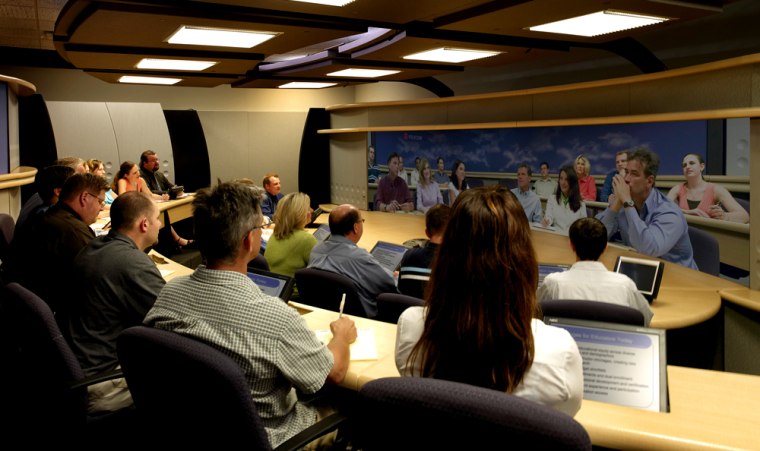Telepresence, simply put, is today’s videoconferencing on steroids. It turns out that videoconferencing reaches a new threshold of reality when the people you’re seeing are nearly life-sized, moving naturally (without that Max Headroom lag-time) and speaking with sound as clear as a CD. One early user compared the telepresence experience to Star Trek’s famed holodeck: it’s as if distant individuals have actually materialized in the room with you.
The telepresence set-up itself is fairly straightforward. Imagine a conference table with six regular chairs on one side and three huge video screens on the other. Make each screen big enough for two life-size head-and-shoulders images, shown in high-definition video with multiple-channel audio, and you have the basic ingredients. Now just add conference attendees at similar setups anywhere else in the world to populate those big screens, and you’re telepresent.
There’s one catch: the pricetag for these magical systems still starts north of $250,000, and at the moment you’ll find most of them at high-flying investment firms where money is no object. Is this just the latest in corporate high-tech indulgence — or a glimpse of the working future? Several converging trends suggest that it’s the latter, and that our current notions of videoconferencing and telecommuting will someday seem as quaint as pneumatic tubes and the steno pool.
Telepresence goes back several decades to the legendary Xerox PARC labs in Silicon Valley (where you would have seen much of today’s personal computer technology as early as the mid-Seventies). In the mid-Eighties, PARC outfitted two labs — one in California, one in Oregon — with an always-on video link connecting their two coffee lounges, so workers could spontaneously meet and converse even when hundreds of miles apart.
The offices also had video cameras and screens scattered throughout, plus various other early forms of collaboration-at-a-distance technology. After several months, the researchers concluded that the technology allowed the individuals at these two different locations to work together as if they were in the same physical space.
The implications of that simple research finding are remarkable: that someday physical distance may make little difference in defining what an “office” is. Yet often people respond to the notion of widespread telepresence with skepticism: nice, maybe, but people will always prefer to meet in person. Or will we?
The more immediate question is whether we will always be able to afford that luxury. The cost of business travel continues to rise — even if we manage to control energy costs, there will be increasing pressure to curtail carbon-generating travel in the face of global warming. Not to mention the fact that travel itself has grown so cumbersome—security precautions, crowded airspaces, unreliable flight schedules — that even the most hardened road warriors are beginning to ask: Is this trip really necessary?
And on the ground in the U.S, it’s getting crowded — 300 million people on the way to 400 million over the next several decades. We’ll add 50 million new licensed drivers by 2020. The cost of traffic congestion alone, in fuel costs and hours lost, is approaching $100 billion a year. In search of affordable family living, Americans are moving further and further from their jobs — almost always to places without mass transit. The result: three hour automobile commutes are increasingly common. Sooner or later, simple economics will beg the question: why not move the work out to where families can afford to live, and link workers to the cities via electrons rather than asphalt?
A younger generation
Finally, there’s one more element that may ultimately be the biggest boon for telepresence: a younger generation — the next workforce waiting in the wings — that is adept at meaningful online relationships. Since childhood they’ve stayed in touch and often even developed strong friendships through online games, texting, IMing and videocams. For them, physical proximity is not as important a part of a successful relationship as it was for their parents. Put them into a telepresence-based working environment and they’re likely to say, why not?
But that’s still some years away. At present, besides the steep prices, only a few manufacturers sell the equipment for telepresence rooms — among them, Cisco, Polycom and Tandberg. The cost is high because telepresence requires sophisticated software to make the systems easy to operate, and sending multiple channels of high definition video over the Internet takes expensive network technology.
Systems at present are also not fully compatible, although work is underway to establish standards. But if there’s one thing that technology history teaches, it’s that hardware, software and bandwidth all get cheaper very quickly. One can imagine telepresence rooms of the future in which one entire wall is a high-definition video screen — opening onto another telepresence room half a planet away.
Leave it to science fiction author Ray Bradbury to have the final word on telepresence. In his 1951 short story “The Veldt” some future parents give their children a nursery with walls that recreate the African veldt so realistically that the father has to reassure the nervous mother: "Walls, Lydia, remember; crystal walls, that's all they are. Oh, they look real, I must admit - Africa in your parlor - but it's all dimensional, superreactionary, supersensitive color film and mental tape film behind glass screens...”
Or so it seems, until father learns that some of the virtual lions are a bit more real than he thinks. Telepresence, of course, won’t create more carnivorous creatures in the workplace than already exist. But it may well become part of the office landscape sooner than most of us expect.
